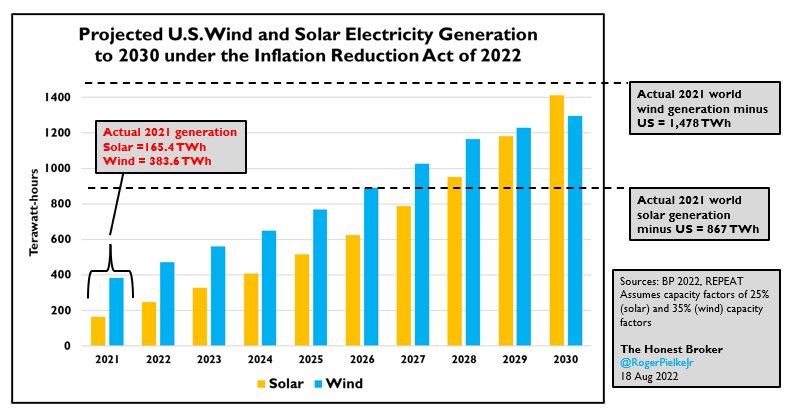Pielke's Weekly Memo #9
A new analysis of solar and wind under the IRA, a historic White House science integrity scandal, some recommended weekend readings, plus a goal of the week
Note for new subscribers: Thanks for subscribing! I use the “Weekly Memo” as a way to highlight some things that crossed my desk over the past days which did not get a full post or which are work in progress that I’d welcome your feedback on. These memos are a bit more informal and a bit more personal than my usual essays. I’ll share these most weeks, except when I am taking a break or on travel.
For August, it sure has been busy in the world of science, policy and politics. But as we all know, it’s a growth industry. In this week’s newsletter I have a three things to share, plus a fun goal of the week.
First, I have conducted a new analysis of the projections (aka predictions/promises) for the expansion of U.S. wind and solar energy generation under the Inflation Reduction Act, which President Biden signed into law earlier this week. There is no doubt that it continues a remarkable run of legislative accomplishments under the Biden Administration (whether you like the legislation or not). However, I still do not see how the promises for expansion of renewable energy square with reality. When you see the graph below, I think you’ll agree (and I’m happy to be convinced otherwise!).
Second, if you follow me on Twitter (and if you don’t , well, you should!) you’ll know that one of the top officials in President Biden’s White House Office of Science and Technology Policy was sanctioned this week by the National Academy of Sciences for serious scientific integrity violations. No one seems to care. I’ll have some thoughts on what that says about our collective deeply partisan approach to science policy.
Third, I’ll also share some recommended readings which might make for some good future posts. I’m lucky that my writing queue here at The Honest Broker is pretty long and that means I can’t write about everything I’d like to — its a good problem to have.
I’ve been receiving a lot of reader mail with some really good suggestions for future posts, among them to discuss my biggest research mistake (a target rich environment, for sure, but I already know what I will write on) and to provide some advice to a CEO wanting to achieve ESG goals but who also understand the risks of greenwashing. Look for both of those posts before too long.
For new readers, I just ungated this piece on the global decarbonization challenge — have a look. And I’ll close today’s memo with another goal of the week — a fun set play from Brazil. Let’s take the jump . . .
Renewable Energy Generation Projected Under the IRA
The figure above shows my first-cut analysis of the projected impact of the Inflation Reduction Act on U.S. electricity generation to 2030. Here I rely on the work REPEAT project, but I would expect the analyses of the other two primary groups supporting the legislation to be similar, since they all arrive at very similar top-line results.
The graph shows implied projections for wind and solar electricity generation to 2030. Here are my methods:
Start with annual projected capacity additions for wind and solar from REPEAT;
Use a capacity factor of 25% for solar and 35% for wind;
Calculate future generation based on cumulative generation capacity in each year.
The projected increases are large — an increase of 8.5x for solar and 3.4x for wind. The projected increase in solar in the U.S. is larger than the world’s total solar generation in 2021, according to BP. Total U.S. wind generation in 2030 approaches but does not exceed the world’s 2021 total for wind generation.
The advocates for the IRA are right about one thing — if this legislation leads to these outcomes it will be a incredible achievement. In a future post I’ll take a close look at the projected decrease in electricity generation from natural gas, which also is quite dramatic, in this case in the other direction. For both renewables and gas, I do not see how these incredible outcomes will actually happen in the real world — but perhaps that says more about me than the real world. We shall see.
A final point. The Washington Post (in an article by Shannon Osaka, one of my favorite climate journalists) observes that the promises for IRA emissions reductions made by Democratic senators and the results of the “independent” analyses are not coincidental:
The agreement between the senators’ claims and the projections is no surprise — the modeling teams were advising Capitol Hill staff on the likely impacts of the deal before it was made public, said Jesse Jenkins, one of the leaders of the Princeton REPEAT modeling project.
As readers here will know well, the conflation of advocacy and analyses is not a recipe for robust policy evaluation. One thing we should all appreciate is that so far at least there are no independent evaluations of the potential consequences of the IRA. Caveat Emptor!
One of the Biggest Science Integrity Scandals in White House History
I don’t say this lightly or hyperbolically. As longtime readers here will recall, last December I wrote a long post on the fact that a top White House official in the Office of Science and Technology Policy — Jane Lubchenco — had been accused of serious violations of research integrity in her role as an editor at the prestigious journal Proceedings of the National Academy of Sciences, prior to assuming her White House position. Trust me, you’ll often hear it here first.
This week we learned that the National Academy of Sciences has sanctioned Lubchenco for those violations. She has been barred “from involvement in NAS publications and activities for five years for violating its code of conduct.” This is, to my knowledge, the most serious scientific integrity violation ever by an OSTP official. It’s a big deal.
Here is what I wrote last December about the details of Lubchenco’s case:
Recently, the Proceedings of the National Academy of Sciences (PNAS) retracted a highly influential paper on marine protected areas and fishing due to identification of significant errors that undercut the paper’s results as well as significant irregularities in the peer review process. What makes this particular retraction of unusual interest is that the irregularities in the PNAS peer review process involve Dr. Jane Lubchenco, the White House official who is currently overseeing President Biden’s Scientific Integrity Task Force.
The paper, A global network of marine protected areas for food (Cabral et al. 2020, hereafter C20), was published by PNAS in October 2020, and has been highly reported on due to its perceived policy relevance. Dr. Lubchenco served as its editor for PNAS. That means that she was responsible for overseeing the paper’s journey through the peer review process, including the selection of reviewers. We now know that Dr. Lubchenco violated PNAS guidelines for conflict of interest, and not unknowingly or in a small way.
I encourage you to have look at that post for further details as well as this commentary by Max Mossler.
The scandal here is not simply that a top OSTP official — who, by the way, is playing a leading role in the Biden Administration’s science integrity initiative — has been sanctioned by the National Academy of Sciences. Though that itself is huge. The bigger scandal is that no one in the broader science community, including science journalists, seems much to care.
For instance, the Editor-in-Chief of Science has found time in the past few days to Tweet about Donald Trump, research integrity and COVID origins, but has not mentioned the Lubchenco sanction. The news story in Science on the Lubchenco sanction included this odd and seemingly exculpatory statement: “Lubchenco’s punishment under its conduct code is the lightest acknowledged by the academy so far.” The other leading science journal, Nature (which is implicated in publishing research connected to the retracted paper) has not even mentioned the case. I’ve seen no comments from leading scientists and scientific associations (let me know if you see anything).
From where I sit this episode, and especially its reception, reflect the deeply partisan nature of science policy nowadays. Bad science — even that leading to retraction, rebuke and sanction — and those responsible are seemingly given a free pass from accountability so long as the offenders are viewed to be on the side of good. As most in the scientific community lean to the left, good and bad are easy to identify using partisan signifiers.
That’s not for me. Here is what I said on Twitter:

If that makes me a bad guy, so be it.
Some Recommended Readings
As usual, I have gone on too much, so let me end with some recommended readings for the weekend:
Maybe economic growth is not exponential — “Additive Growth,” by Thomas Phillippon (HT Noah Smith whose post makes for an excellent companion piece). I’ll get into economic growth and its relation to technology in future posts — a favorite topic of mine.
Hurricane season has been a dud so far, but don’t expect that to continue — In this Twitter thread I explain why and link to several of our papers that explain why the action really starts at the end of August and that La Niña years (like this year) have much more U.S. damage.
Does the IRA simply mean we have a new set of special energy interests at the head of the table? Adam Tooze has an interesting and provocative podcast on the “Green Industrial Complex.”
A remarkable story out of Utah about how parents are using anti-trans policies to target school girls is youth sport for not being feminine enough, disgusting. I’ll have more on evolving trans eligibility policies in elite sport in weeks to come.
And Finally a Goal of the Week … Enjoy!








My concern is that there is growing sense of entitlement and privilege among the progressive side, such that rules don’t apply and if there is an issue, the media will run cover. Simply saying “I regret” is viewed as enough.
Regarding that "incredible achievement", that 1.5 GT reduction in GHG emissions in 2030 nets 0.75 additional GT in the atmosphere as the other half is sequestered in the biosphere and the oceans. The current ~35 GT of industrial CO2 yields ~+2 ppm of CO2. A doubling of CO2 (currently ~420 ppm) yields ~1.1C of warmth. For the year 2030, we then have an impact of (0.75/35)*2 = 0.0429 ppm; and (0.0429/420) * 1.1 = +0.0001122 C temperature reduction. I know that in reality the trends are not linear, but this ridiculously small impact illustrates the futility of the Prosperity Reduction Act. Extend that out 70 years to 2100 and we will have saved the planet from warming an incredible 0.008C! Lomborg plugged the numbers into the MAGICC model which yields a savings of 0.016 C. The achievement would be incredibly harmful.